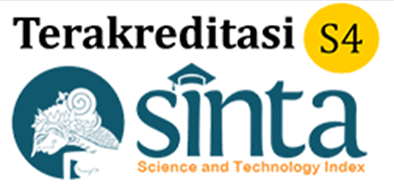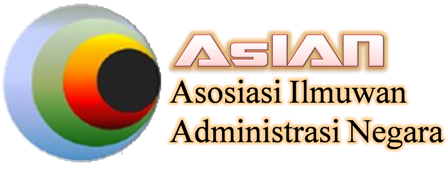Konteks Organisasi, Teknologi Informasi dan Kapabilitas Knowledge Sharing Pegawai di PT PLN (Persero) Area Palembang
Abstract
Rapid changes in the information age indirectly require reforms in the public sector. The public sector must continue to improve, one of which is through the creation of innovation. Innovation in the public sector is carried out through the creation of ideas that cannot be separated from the knowledge sharing process. Knowledge sharing is important for organizations considering the nature of knowledge which is complementary and no single individual masters all fields of knowledge. Unfortunately, not many public agencies have implemented knowledge management properly through the use of information technology by considering organizational culture and the type of organizational structure. The purpose of this study was to examine how the influence of internalization of organizational culture and functional organizational structure on knowledge sharing capability at PT. PLN (Persero) Palembang Area by including information technology as an intervening variable. The method used in this study is a quantitative method using a questionnaire as primary data. The sample used in this study is a census sample so that the entire population is used as research respondents. The results showed that the use of information technology mediates the effect of internalization of organizational culture on knowledge sharing capabilities but does not mediate the effect of functional organizational structures on knowledge sharing capabilities. Based on these findings, the suggestions given by the researcher are: maximizing the use of information technology while maintaining a conducive organizational culture and climate for increasing knowledge sharing capabilities.
References
Baek, Jong-Deuk. (2007). The Effect of Individual,Organizational & Health Care System Factors on Physicians’ Information Technology Use, Disertation, South Carolina: University of South Carolina.
Bashorat et al (2012). Understanding the Antecedents of Knowledge Sharing: An Organizational Justice Perspective. University of North Texas: USA.
Borins, S. (2014), The Persistence of Innovation in Government. Washington D.C: Brookings Institution Press with Ash Center for Democratic Governance and Innovation.
Buckley, P.J. and Casson, M.C (1976). The Future of the Multinational Enterprise, London: Macmillan.
Budihardjo, Andreas. (2016). Knowledge Management: Efektif Berinovasi Meraih Sukses, Jakarta: Prasetya Mulya Publishing.
Cohen, Don and Laurence Pruskak. (2001). In Good Company: How Social Capital Makes Organization Work. Boston: Harvard Business School Press.
Cooper, Donald R. Dan Schindler, Pamela S. (2014). Bussiness Research Method, 12th edition. McGraw-Hill International Edition.
Creswell, John W. (2010). Research Design: Pendekatan Kualitatif, Kuantitatif dan Mixed, Yogyakarta: Pustaka Pelajar.
Creswell, J.W., & Plano Clark , V.L. (2007). Designing and Conducting Mixed Method Research. Thousand Oak, CA: SAGE.
Dalkir.K. 2005. Knowledge Management in Theory and Practice. Oxford, UK: Elsevier Butterworth- Heinemann.
Davila, T., Epstein, M.J and Shelton, R. (2006). Making Innovation Work: How to Manage it, Measure it, and Profit from it, Pearson Education, Upper Saddle River, NJ.
Dwimadyasari, Vira & Susanty, Ade I. (2015). Pengaruh Faktor Individu, Organisasi & Teknologi terhadap Knowledge Sharing, E-Proceeding of Management: Vol. 2:1, 23-29
Eid, M. & Al- Jabri. (2016). Social Networking, Knowledge Sharing and Student Learning: The Case of University Students, Computers and Education, 99: pp. 14-27.
Frappaolo, C. (2006). Knowledge Management. Chichester: West Sussex: Capstone Publishing Ltd.
Ismail, Mohd bahari dan Zawiyah, M. Yusof. (2008) Factors Affecting Knowledge Sharing in Public Organization in Malaysia, in Knowledge management International Conference and Exhibition,
Kusumadmo, E. (2013). Manajemen StrategikPengetahuan. Yogyakarta: Cahaya Atma Pustaka.
Maksum, Ali. (2012). Metode penelitian. Surabaya: Unesa University Press.
Marshal, Catherine dan Rossman, Gretchen B (1995). Designing Qualitative Research. California: Sage Publication,.Inc.
Marquardt, Michael J. 2002. Building the Learning Organization. Palo Alto, CA: Davies- Black Publishing.
North, Klaus & Gita Kumta. (2014). Knowledge Management: Value Creation Through Organizational Learning. London: Springer International Publishing.
Nurmandi, Achmad. (2016). Implementasi Knowledge Management pada Organisasi Publik, Yogyakarta: Sinergi Publishing.
Pandey, Krishna Nath. 2014. “Knowledge Management Processes : A Case Study of NTPC and POWERGRID.” 2(i): 133–49.
Putra, Nusa dan Hendarman. (2013). Metode Riset Campur Sari, Jakarta: PT. Indeks.
Raharso, Sri & Tjahjawati, Sri Surjani. (2016). Organisasi Berbasis Pengetahuan Melalui Knowledge Sharing, Bandung: Alfabeta.
Sarwono, Jonathan. (2006). Metode Penelitian Kualitatif dan Kuantitatif, Yogyakarta: Graha Ilmu.
Sekaran, Uma. (2010). Research Method for Bussiness: A Skill Building Approach, New York: John Wiley and Sons, Inc.
Skyrme.D.J & Amindon, D.M. (1997). Creating Knowledge Based Business. London: Business Intelligence, Ltd.
Sugiyono. (2006). Metode Penelitian Administrasi, Bandung: Alfabeta.
________ (2011). Metode Penelitian Kuantitatif Kualitatif dan R & D, Bandung: Alfabeta.
Tofler, Alfin. (1980). The Future Shok “Third Wave”. New York : Bantam Book.
Von Krogh, George. (1998). Care in Knowledge Creation: California Management Review. 40 (3): 133-153.
Wagner, Vollmar, G. & Wagner, H.T. (2014). The Impact of Information Technology on Knowledge Creation. Journal of Enterprise Information Management, 27 (1), pp.31-44.
Wiig, K.M. (1999). Introducing Knowledge Management into the Enterprise. dalam Liebowitz, J. Ed., Knowledge Management Handbook, Boca Raton CRC Press,p.III-7 19.
Zamroni, Pengantar Pengembangan Teori Sosial,Yogyakarta: PT Tiara Wacana , 1992.
Alavi, M., & Leidner, D.E. (2001). Knowledge Management and Knowledge Management System: Conceptual Foundationand Research Issues. MIS Quarterly, Vol 25 (1), pp.107-136.
Badaracco, J.L., Jr.(1991). Alliances Speed Knowledge Transfer, Planning Review, Vol 19 (2), pp.10-16.
Bock, G. & Kim, Y. (2002). Breaking the Myths of Rewards, Information Resource Management Journal, Vol 15 (2), pp. 14-21.
Buckley, Peter and Carter, Martin J. (2003), Governing Knowledge Sharing in Multinational Enterprises, Management International Review, Vol 43 (3) pp. 7-25.
Calanton , R.J. Cavusgil, S.T.and Zhao, Y.(2002), Learning orientation, firm Innovation Capability and Firm Performance, Industrial Marketing Management, Vol 31 (6), pp. 515-524.
Claver- Cortes, Zaragoya- Saez and PertusaOrtega. (2007), Organizational Structure Features Supporting Knowledge Management Process, Journal of Knowledge Management, Vol 11 (4), pp 45- 57.
Dewah, Peterson & Mutula, Stephen M. 2016. Knowledge Retention Strategies in Public Sector Organizations : Current Status in Sub-Saharan Africa. Information development, Vol 32(3): pp. 362–76.
Dwimadyasari, Vira & Susanty, Ade I. (2015). Pengaruh Faktor Individu, Organisasi & Teknologi terhadap Knowledge Sharing, E-Proceeding of Management: Vol. 2:1, 23-29.
Gold, A., Malhotra, A., A. Segars. (2001). Knowledge Management: An Organizational Capabilities Perspective, Journal of Management Information System. 18 (1): 185-214.
Hansen, M.T. (1999). The Search-Transfer Problem: The Role of Weak Ties in Sharing Knowledge Across Organization Subunits, Administreative Science Quarterly, Vol 44 (1), pp. 82-111.
Hoof, Bart van den & Ridder, Jan A. (2014). Knowledge Sharing in Context: The Influence of Organizational Commitment, Communication Climate and CMC Use on Knowledge Sahring, Journal of Knowledge Management, Vol. 8 (6), pp. 117-130.
Ipe, Minu (2003). Knowledge Sharing in Organization, Human resource Development Review, Vol 2, No 4, pp. 337-359.
Lowendahl, B.R.,Revang, O. & Fosstenlokken, S.M. (2001). Knowledge and Value Creation in Professional Service Firm: A Framework for Analysis, Human Relation, Vol 54(7), pp. 911-931.
Magni, Massimo, Corey M. Angst dan Ritu Agarwal. (2012). Everybody Needs Somebody: The Influence of Team Network Structure on Information Technology Use, Journal of Management Information System, Vol 29: 3, pp. 9-24.
McDermott, R. & O’Dell, C. (2001). Overcoming Cultural Barriers to Sharing Knowledge, Journal of Knowledge Management, Vol 5 (1), pp. 76-85.
Nahapiet, J. dan Ghoshal, S. (1998), Social Capital, Intellectual Capital and the Organizational Advantage, Academy of Management Review, Vol 23 (2), pp. 242- 266.
Noor, Noorazah Md dan Salim, Juhana. (2011). Factors Influencing Employee Knowledge Sharing Capabilities in Electronic Government Agencies in Malaysia, International Journal of Computer Science Issues, Vol. 8 (2), pp. 106-114.
Okyere-Kwakye, E. & Nor, K.M. (2011). Individual factors and Knowledge Sharing. American Journal of Economics and Business Administration, Vol 3 (1), pp.66-72.
Osterloch, M., & Frey, B. (2000). Motivation, Knowledge Transfer, and organisational forms. Organization Science, Vol 11, pp.538-550.
Parsons, Sarah, Harry Daniels, Jill Porter dan Robertson. (2008). Resources, Staff Beliefs and Organizational Culture: Factor in the Use of Information and Communication Technology fo Adults with Intellectual Disabilities, Journal of Applied Research in Intellectual Disabilities, Vol 21, pp. 19-33.
S. Vargo and Lusch, (2004), Evolving to a New Dominant Logic for Marketing. Journal of Marketing, Vol 68 (January), p.1-17.
Saenz, Josune, Nekane Aramburu & Olga Rivera. (2009). Knowledge Sharing and Innovation Performance, Journal of Intellectual Capital, Vol 10 (1), 22-36.
Sanchez, J.H., Collado-Ruiz D. & Cebrian Tarrason D. (2013). Knowledge Creating and Sharing: Corporate Culture Framework. Procedia-Social and Behavioral Science. Vol 5 (4). Pp. 311-321.
Scarbrough, H. (2003). Knowledge Management, HRM and Innovation Process, International Journal of manpower , Vol 24 (5), pp.501-516.
Steiger et al. (2014). An Examination of the Influence of Organizational Structure Types and Management Levels on Knowledge Management Practices in Organization, International Journal of Business and Management, Vol 9 (6); pp. 43- 57.
Storey, Chris, and Kenneth B Kahn. (2010). The Role of Knowledge Management Strategies and Task Knowledge in Stimulating Service Innovation. Journal of Service Research,Vol 13 (4) pp. 397-410.
Supriyono., R.A. (2004). Pengaruh Variabel Intervening Kecukupan Anggaran dan Komitmen Organisasi terhadap hubungan antara Partisipasi Anggaran dan Kinerja Manajerial, Jurnal ekonomi dan Bisnis Indonesia. Vol. 19. No 3, pp 282- 298.
Raharso, Sri. 2011. Pekerja Pengetahuan (Knowledge Worker): Konsepsi dan Tantangan pengelolaan, Jurnal Manajemen Usahawan Indonesia, Vol 40 (1),hlm. 58-74.
Razmerita, Kirchner dan Nielsen. (2016). What Factors Influence Knowledge Sahring in Organization? A Social Dilemma Perspective of Social Media Communication, Journal of Knowledge Management, Vol 20 (6). Pp.1225-1246.
Vera-munoz, S.C., Ho, J.L. & Chow, C.W. (2006). Enhanching Knowledge Sharing in Public Accounting Firms, Accounting Horizons, Vol 20, pp. 133-155.
Raharso, Sri. 2011. Pekerja Pengetahuan (Knowledge Worker): Konsepsi dan Tantangan pengelolaan, Jurnal Manajemen Usahawan Indonesia, Vol 40 (1),hlm. 58-74.
Razmerita, Kirchner dan Nielsen. (2016). What Factors Influence Knowledge Sahring in Organization? A Social Dilemma Perspective of Social Media Communication, Journal of Knowledge Management, Vol 20 (6). Pp.1225-1246.
Vera-munoz, S.C., Ho, J.L. & Chow, C.W. (2006). Enhanching Knowledge Sharing in Public Accounting Firms, Accounting Horizons, Vol 20, pp. 133-155
Copyright (c) 2021 Supardi Supardi

This work is licensed under a Creative Commons Attribution 4.0 International License.













